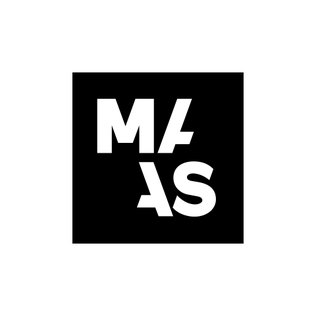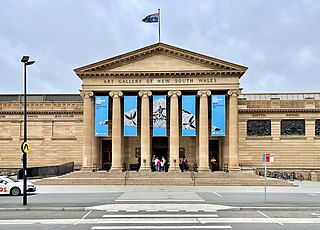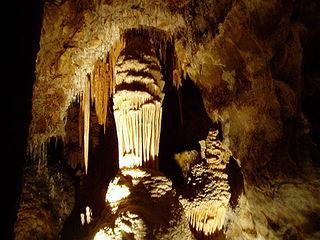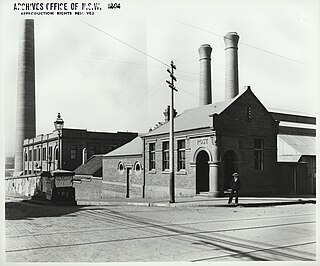Related Research Articles

The Powerhouse Museum is the major branch of the Museum of Applied Arts & Sciences (MAAS) in Sydney, the others being the historic Sydney Observatory at Observatory Hill, and the newer Museums Discovery Centre at Castle Hill. Although often described as a science museum, the Powerhouse has a diverse collection encompassing all sorts of technology including decorative arts, science, communication, transport, costume, furniture, media, computer technology, space technology and steam engines.

The Australian Museum is a heritage-listed museum at 1 William Street, Sydney central business district, New South Wales, Australia. It is the oldest museum in Australia, and the fifth oldest natural history museum in the world, with an international reputation in the fields of natural history and anthropology. It was first conceived and developed along the contemporary European model of an encyclopedic warehouse of cultural and natural history and features collections of vertebrate and invertebrate zoology, as well as mineralogy, palaeontology and anthropology. Apart from exhibitions, the museum is also involved in Indigenous studies research and community programs. In the museum's early years, collecting was its main priority, and specimens were commonly traded with British and other European institutions. The scientific stature of the museum was established under the curatorship of Gerard Krefft, himself a published scientist.

The State Library of New South Wales, part of which is known as the Mitchell Library, is a large heritage-listed special collections, reference and research library open to the public. It is the oldest library in Australia, being the first established in the colony of New South Wales in 1826. The library is located on the corner of Macquarie Street and Shakespeare Place, in the Sydney central business district adjacent to the Domain and the Royal Botanic Gardens, in the City of Sydney. The library is a member of the National and State Libraries Australia (NSLA) consortium.

The Art Gallery of New South Wales (AGNSW), founded as the New South Wales Academy of Art in 1872 and known as the National Art Gallery of New South Wales between 1883 and 1958, is located in The Domain, Sydney, Australia. It is the most important public gallery in Sydney and one of the largest in Australia.

The Jenolan Caves are limestone caves located within the Jenolan Karst Conservation Reserve in the Central Tablelands region, west of the Blue Mountains, in Jenolan, Oberon Council, New South Wales, in eastern Australia. The caves and 3,083-hectare (7,620-acre) reserve are situated approximately 175 kilometres (109 mi) west of Sydney, 20 kilometres (12 mi) east of Oberon and 30 kilometres (19 mi) west of Katoomba.

The Parliament House in Sydney is a heritage-listed complex of buildings housing the Parliament of the state of New South Wales, Australia. The building is located on the east side of Macquarie Street in Sydney, the state capital. The façade consists of a two-storey Georgian building, the oldest public building in the City of Sydney, flanked by two Neo-gothic additions containing the parliamentary chambers. These buildings are linked to a 1970s 12-storey block at the rear, facing onto the Domain. It is also known as Parliament of New South Wales, Parliamentary Precincts and the Rum Hospital.

The Chief Secretary's building is a heritage-listed state government administrative building of the Victorian Free Classical architectural style located at 121 Macquarie Street, 65 Bridge Street, and at 44-50 Phillip Street in the Sydney central business district of New South Wales, Australia. The ornate five-storey public building was designed by Colonial Architect James Barnet and built in two stages, the first stages being levels one to four completed between 1873 and 1881, with Walter Liberty Vernon completing the second stage between 1894 and 1896 when the mansard at level five and the dome were added.

The Department of Lands building is a heritage-listed state government administrative building of the Victorian Renaissance Revival architectural style located in Bridge Street in the Sydney central business district of New South Wales, Australia. The large three-storey public building was designed by Colonial Architect James Barnet and built in different stages, with Walter Liberty Vernon and William Edmund Kemp designing various components of the building. The builder was John Young.

Bridge Street is a street in the central business district of Sydney in New South Wales, Australia. Bridge Street runs for 500 metres (1,600 ft) in a west–east direction with traffic flowing in both directions. It is situated in the northern portion of the central business district. The western terminus of Bridge Street is at George Street, with the eastern terminus at Macquarie Street, adjacent to the Chief Secretary's Building. From west to east, Bridge Street crosses Pitt and Phillip streets.

The Justice and Police Museum is a heritage-listed former water police station, offices and courthouse and now justice and police museum located at 4-8 Phillip Street on the corner of Albert Street, in the Sydney central business district in the City of Sydney local government area of New South Wales, Australia. It was designed by Edmund Blacket, Alexander Dawson and James Barnet and built from 1854 to 1886. It is also known as Police Station & Law Courts (former) and Traffic Court. The property is owned by the Department of Justice, a department of the Government of New South Wales. It was added to the New South Wales State Heritage Register on 2 April 1999.

Broken Hill Post Office is a heritage-listed post office at 258-260 Argent Street, Broken Hill, City of Broken Hill, New South Wales, Australia. The original building was designed by James Barnet, and was built from 1890 to 1892 by John Dobbie. Walter Liberty Vernon designed a telegraph office addition in 1900. The property is owned by Australia Post. It was added to the New South Wales State Heritage Register on 22 December 2000. It was added to the Australian Commonwealth Heritage List on 08 November 2011.

Old Wollongong East Post Office is a heritage-listed former post office, telegraph office and telephone exchange at 91 Crown Street, Wollongong, City of Wollongong, New South Wales, Australia. It was designed by the NSW Colonial Architect's Office and built from 1890 to 1892 by Messrs Banks and Whitehouse. Prior to 1968, it was also known as Wollongong Post and Telegraph Office or Wollongong Post Office. It was added to the New South Wales State Heritage Register on 24 January 2003.

The Department of Mineral Resources Historic Photographs Collection is a heritage-listed photographic collection at 516 High Street, Maitland, City of Maitland, New South Wales, Australia. It was established from 1860. It is also known as the Geological Survey collection of historic images. It was added to the New South Wales State Heritage Register on 2 April 1999.

Pyrmont Post Office is a heritage-listed former post office and now bank branch office located at 148 Harris Street, in the inner city Sydney suburb of Pyrmont in the City of Sydney local government area of New South Wales, Australia. It was designed by the Government Architect’s Office under Walter Liberty Vernon. The property is owned by Australia Post, an agency of the Commonwealth Government of Australia. It was added to the Australian Commonwealth Heritage List on 22 June 2004 and to the New South Wales State Heritage Register on 22 December 2000.

The Ultimo Post Office is a heritage-listed former post office located at 494 Harris Street in the inner city Sydney suburb of Ultimo in the City of Sydney local government area of New South Wales, Australia. The property is owned by Trustees of the Museum of Applied Arts and Science, an agency of the Government of New South Wales. It was added to the New South Wales State Heritage Register on 2 April 1999.

The Old Bushells Factory is a heritage-listed former Bushells Tea factory and warehouse, now used as shops, offices and an art gallery, located at 86-88 George Street in the inner city Sydney suburb of The Rocks in the City of Sydney local government area of New South Wales, Australia. No. 86 was designed by Walter Liberty Vernon; and both buildings were built from 1886 to 1912. It is also known as the Old Bushells Factory and Warehouse; Bushells Place; Bushells Warehouse and Bushells Offices; and Health Commission Building (Bushell's). The property is owned by Property NSW, an agency of the Government of New South Wales. It was added to the New South Wales State Heritage Register on 10 May 2002.

The Old Mining Museum building is a heritage-listed former chemical laboratory and mining museum and now commercial building located at 36-64 George Street in the inner city Sydney suburb of The Rocks in the City of Sydney local government area of New South Wales, Australia. It was designed by Walter Liberty Vernon and built from 1902 to 1909. It is also known as Mining Museum (former), Earth Exchange and Sydney Geological and Mining Museum. The property is owned by Property NSW, an agency of the Government of New South Wales. It was added to the New South Wales State Heritage Register on 10 May 2002.

The Public Trust Office is a heritage-listed office building at 19–21 O'Connell Street, Sydney, Australia. It was designed by Ross & Rowe and built from 1926. It is also known as the Public Trustee. It was originally known as Rofe Chambers. It was added to the New South Wales State Heritage Register on 2 April 1999.

The Young Street Terraces are heritage-listed former government offices and nurses' quarters, and now offices, at 36-42 Young Street, in the Sydney central business district in the City of Sydney local government area of New South Wales, Australia. Its design and construction was attributed to Joseph Paul Walker and built from 1874 to 1875. It is also known as the Sydney Hospital Nurses Annex; Nurses quarters; or Government Offices. It was added to the New South Wales State Heritage Register on 2 April 1999.

93-97 Macquarie Street, Sydney or formerly the Health Department building is a heritage-listed former government office, health clinic and hospital admissions depot and now hotel at 93-97 Macquarie Street, in the Sydney central business district, in the City of Sydney local government area of New South Wales, Australia. It was designed by Walter Liberty Vernon and NSW Government Architect and built from 1896 to 1898. It is currently part of the Sir Stamford Hotel, which formerly was a Ritz Carlton Hotel. In its history it has also been used as the Venereal Disease Clinic, STD Clinic, Hospital Admissions Depot and Former Health Board Offices. It was added to the New South Wales State Heritage Register on 9 October 2013.
References
- 1 2 Sydney Harbour Foreshore Authority. "Mining Museum (former) Statement of Significance Heritage and Conservation Register". www.shfa.nsw.gov.au. Archived from the original on 16 December 2017. Retrieved 10 December 2019.
- 1 2 3 4 5 "The Earth Exchange Building". www.visitsydneyaustralia.com.au. Retrieved 12 July 2019.
- ↑ "MINING AND GEOLOGICAL MUSEUM". Sydney Morning Herald (NSW : 1842 - 1954). 10 December 1887. p. 10. Retrieved 10 December 2019.
- ↑ Card, George William; Geological Survey of New South Wales (1902). Handbook to the Mining and Geological Museum, Sydney. W.A. Gullick, government printer.
- 1 2 3 4 Burton, Christine (2006). "Here to stay : the role of value creation, capture and exchange in limiting the liability of newness for new entrant museums" (PDF). Archived (PDF) from the original on 19 July 2019. Retrieved 19 July 2019.
- ↑ New South Wales Department of Public Works; New South Wales Department of Mineral Resources (1988). Redevelopment of the Mining Museum, Sydney.
- ↑ Garner, B. (1982). "Economic Strategy for the Mining Museum". Minute Paper State Records AK520 Box 5.
- ↑ Cochrane, P. "How Sydney became the Cultural Capital". Sydney Morning Herald. p. 50.
- 1 2 3 4 5 Burton, C. (1 June 2007). "How a museum dies: The case of new entry failure of a Sydney museum". Museum Management and Curatorship. hdl:10453/1160. ISSN 0964-7775.
- ↑ "THE SYDNEY MINING MUSEUM". Sydney Stock and Station Journal (NSW : 1896 - 1924). 30 December 1910. p. 15. Retrieved 10 December 2019.
- ↑ Earth Exchange Annual report 1990-1. Trustees of the Earth Exchange and Geological Mining Museum. 1991.
- ↑ "Albert Chapman collection". The Australian Museum. Archived from the original on 28 February 2019. Retrieved 10 December 2019.